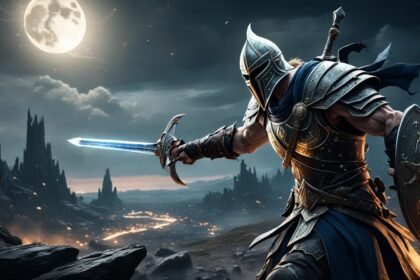American History X is a significant film from 1998. It focuses on racism, hate groups, and the fight for cultural diversity in the U.S. Directed by Tony Kaye, it introduced Edward Norton as the main character, Derek Vinyard. The story challenges what society thinks and helps people look at their own prejudices.
When it came out, the film received wide praise. It opened discussions about racism and how people can change. However, making the movie wasn’t easy. Tony Kaye even sued major entities over the making of the film.
Edward Norton, a dedicated actor, showed his commitment by making big changes to the film after it was done. These changes shaped the movie into a compelling story that people still connect with today.
Originally, the film’s end was more violent. Norton decided to alter it to give a message of hope instead. This change highlights the theme of redemption and the chance for people to change, even after facing terrible events.
Key Takeaways
- American History X, released in 1998, continues to have a profound impact on culture.
- The film explores the themes of racism and redemption in American society.
- Edward Norton’s performance as Derek Vinyard is highly acclaimed.
- The film underwent significant editing changes to convey a message of hope.
- American History X challenges social norms and prompts viewers to confront their own biases.
The Origins of the Civil Rights Movement
The Civil Rights Movement began after World War II. It was a fight against racial segregation and discrimination, especially in the Southern U.S. This important effort aimed to give African Americans the same rights and chances as everyone else.
In the late 1800s, laws called “Jim Crow” laws made segregation stronger, especially in public places. These laws kept Black and white people apart, leading to more discrimination and exclusion.
The Movement became stronger with leaders like Martin Luther King Jr. He used peaceful protest and encouraged others to do the same. His actions inspired many to fight for equal rights.
A big step was made when Rosa Parks didn’t move from her bus seat in 1955. This led to the Montgomery Bus Boycott, which lasted over a year. It ended with a court ruling against segregated bus seating.
The fight continued with the Greensboro sit-ins and Freedom Rides in the early 1960s. These events brought more focus on the fight against segregation.
One of its biggest moments was the March on Washington in 1963. More than 200,000 people marched for civil rights, jobs, and equality. Martin Luther King Jr. gave his famous “I Have a Dream” speech at this event.
Things changed for the better when President Lyndon B. Johnson signed the Civil Rights Act in 1964. This important law made sure all jobs were open to everyone, regardless of race. It also ended segregation in public places.
The Civil Rights Movement was deeply rooted in America’s history. It picked up more support over decades through court cases and laws. This includes the 1954 Brown v. Board of Education decision that said separate schools were not equal.
The hard work of activists and leaders set the stage for ongoing fights for equality. Their efforts inspired movements for gender and LGBTQ rights. Their legacy continues today.
| Key Events | Date |
|---|---|
| 14th Amendment grants Black people equal protection under the law | 1868 |
| 15th Amendment gives Black American men the right to vote | 1870 |
| “Jim Crow” laws segregate Black people from white people in public facilities | Late 19th century |
| Executive Order 8802 opens national defense and government jobs to all Americans regardless of race | 1941 |
| Executive Order 9981 issued to end discrimination in the military | 1948 |
| Montgomery Bus Boycott ends with Supreme Court ruling segregated seating unconstitutional | November 14, 1956 |
| Civil Rights Act of 1957 allows federal prosecution for voter discrimination | September 9, 1957 |
| Greensboro sit-ins spark movement against segregation at Woolworth’s lunch counter | February 1, 1960 |
| Freedom Rides challenge segregated facilities on bus tours | May 1961 |
| March on Washington draws over 200,000 people advocating for civil rights legislation and job equality | 1963 |
| Civil Rights Act of 1964 guarantees equal employment opportunities and integrates public facilities | July 2, 1964 |
Music and the Movement
During the Civil Rights Movement, music was a key way to unite people and highlight the fight against racism. Artists like Nina Simone, Sam Cooke, and Bob Dylan spoke out against racial injustice through their songs. They turned their music into activism.
“We Shall Overcome” became a powerful anthem for equality, linking arms in the Civil Rights Movement’s struggle. Its roots in the 1940s labor movement grew, and folksinger Pete Seeger helped bring it to popularity. This song united people in their hope and determination for a better future.
Nina Simone bravely challenged societal norms with her music, sparking conversations about racial injustice. Her impactful performance of “Mississippi Goddam” at Carnegie Hall in 1964 shook up the audience. It called for immediate change and unveiled the harsh realities of racism.
Dr. Martin Luther King Jr. and Musical Expression
Dr. Martin Luther King Jr. highlighted music’s role in changing society. In 1964, he spoke about jazz’s democratic nature and its ability to bring people together. He recognized jazz as a universal voice connecting humanity.
“Jazz speaks for life. The Blues tell the story of life’s difficulties… Jazz speaks to our condition in a language that is deep within us all.”
The music scene during the Civil Rights Movement was rich and varied, spanning gospel, jazz, folk, and soul. These genres were fueled by personal experiences and the fight for equality. The resulting music deeply connected with those pushing for social change.
This music offered hope and unity, becoming a rallying cry for the movement. It showed that activism wasn’t just protests but also in artistic expressions. Its power brought diverse people together for a shared cause.
Musicians in the Civil Rights era turned their art into a catalyst for social changes. The songs they wrote continue to inspire action today. They remind us of the essential role music and creativity play in the fight for a fairer society.
Literature and Artistic Expression
The Civil Rights Movement of the 1960s brought big changes in American society. It also started a new wave in African American writing and art. Authors like James Baldwin and Maya Angelou became big voices. They talked about race, fighting back, and hope in their work. This made the African American experience more visible during that time.
| Writer | Notable Works |
|---|---|
| James Baldwin | Notes of a Native Son, The Fire Next Time, Another Country |
| Maya Angelou | I Know Why the Caged Bird Sings, Phenomenal Woman, And Still I Rise |
James Baldwin wrote books like Notes of a Native Son and The Fire Next Time. They talked about the African American journey and fought against wrong beliefs. Maya Angelou’s work, I Know Why the Caged Bird Sings, told her story of finding herself and staying strong.
“Books let us dive deep into what it means to be human. Through the words of Baldwin, Angelou, and other African American writers, we see the fight for rights. Their stories and poems are still teaching us, showing the strong spirit of the Civil Rights Movement.”
Art was another way for people to show who they were and what they wanted. Romare Bearden and Jacob Lawrence used their art to highlight and honor African American life. Bearden’s mixes and Lawrence’s colorful art showed the Civil Rights Movement’s effect on people.
Key Artists of the Civil Rights Movement
- Romare Bearden
- Jacob Lawrence
These artists and more played a big part in a new cultural rise at that time. They gave a picture to the African American fight for equal rights.
The writing and art from the Civil Rights Movement still matter a lot today. They help new groups look at the past, cheer for changes, and ask for more. The work of these artists and writers has made a lasting impression. It shows how important creativity and speaking up are in making a fairer society.
The Role of Media
During the Civil Rights Movement, the media was crucial. Television and newspapers showed the harsh truth of racial violence. They brought it into everyone’s homes, sparking anger across the nation.
For example, the Birmingham campaign showed attacks on peaceful protesters. This revealed the racism and discrimination African Americans endured. Such images made the public demand change.
“The exposure of racial violence and injustice through various media outlets garnered sympathy for the Civil Rights Movement and helped spread its message of equality and justice.”
Newspapers also played a vital role, telling detailed stories of the movement’s struggle. Journalists courageously reported the activists’ fight and the challenges they faced. Their work was key in rallying support for the cause.
The media portrayed activists as brave souls fighting for justice. This moved viewers and created a deep connection to the movement. By narrating personal stories, the press made the fight for civil rights more relatable.
TV and newspapers changed the game. They got the public to support civil rights, need change urgently, and rethink their views on race. Without their coverage and stories, the movement might not have succeeded.
Shaping Social Norms
The Civil Rights Movement fought against segregation and racial inequality. It aimed to bring integration and equality.
Its impact stretched to changing how people think about racial equality. This happened as white Americans saw the wrongs faced by African Americans.
The movement made people support racial integration. It taught about equality and justice, affecting all of life in America.
Integration became a big topic in schools, work, and communities. White Americans checked their own unfair ideas. They worked to end segregation.
This change faced difficulties but spurred many to work for fairness. It increased working across races and understanding each other.
“We don’t want to create a society where color doesn’t matter; we want to create a society where color doesn’t matter as much.” – Civil rights activist
The movement’s strong moments included key scenes like Derek’s change in “American History X.” This film showed racism’s complex nature and the chance for change.
| Elements of Social Norms Shaped by the Civil Rights Movement | Impact |
|---|---|
| Institutionalized segregation | Challenged and dismantled, paving the way for integration |
| Negative stereotypes and bias | Confronted and actively addressed through awareness and education |
| Racial inequality and discrimination | Exposed and gradually less tolerated |
| Lack of interracial collaboration | Prompted a rise in alliances and partnerships for racial equality |
Educational Impact and Lasting Change
Education was key in changing social norms for integration and equality. Schools helped build understanding, empathy, and promote cultural exchange.
By mixing students from different backgrounds, they tackled old biases. This brought respect and unity among students.
The Civil Rights Movement changed how we teach about equality and justice. This is seen in today’s efforts for a diverse, fair society. Educators keep teaching to shape better futures.
In conclusion, the Civil Rights Movement played a key role in reshaping America. It challenged segregation and inspired a drive for equal rights and unity.
Education and Awareness
The Civil Rights Movement made big political and cultural changes. It included integrating schools and universities. This move gave African Americans more chances for education and brought people from different backgrounds together.
Opening up schools played a key role in promoting understanding and including everyone. It let African American students attend integrated schools. Here, they could learn alongside students from all walks of life. This helped in understanding and accepting one another better.
In these mixed classrooms, students encountered various views and experiences. This helped to change their ideas and fight against racial stereotypes. Education thus emerged as a strong weapon against prejudice. It helped raise a generation that saw the value in equality and sharing different cultures.
Power of Inclusive Education
Studies by Ghosh and Abdi (2013) show that inclusive education is crucial for fairness in schools (p. 49). Teachers are vital in creating this environment. They can ensure all students feel included. This counters prejudice and helps students feel like they belong.
By making classrooms diverse, teachers can challenge student biases. They encourage empathy and insight through open talks. This makes students think deeply about racism and inequality, promoting change.
Impact Beyond the Classroom
Inclusive education benefits not just students but also the community and society. It equips students with the knowledge to fight for fairness and justice. They become champions of equality and spread these values.
Education also affects parents and caregivers. They learn from their children’s inclusive education. This encourages them to overcome their own biases. It creates a supportive home environment, aligning with what is taught in schools.
“Education is the most powerful weapon which you can use to change the world.” – Nelson Mandela
A film called African History Y is in the works. It connects education and cultural understanding to fight racism. By promoting these values, it hopes to make society more inclusive, inspired by the Civil Rights Movement.
Education and awareness keep the Civil Rights Movement’s message alive. By encouraging inclusive learning and exchanging cultures, we push for a fairer future. This is how we progress and work towards equality.
Influence on Subsequent Movements
The Civil Rights Movement greatly influenced fights for gender equality, LGBTQ rights, and more. It taught effective strategies that became important for various groups wanting to make a change. This led to a wave of global activism, showing how universal its lessons were.
The Movement taught that nonviolent protest can challenge big issues and make a difference. Movements that followed looked to its bravery and used similar peaceful methods for change. This approach inspired many to join in against inequality.
In the fight for gender equality, the Civil Rights Movement served as a guide. Both men and women found courage in its fight for justice. They applied these lessons to issues like workplace fairness and rights over their own bodies. This helped start a strong sense of community and power among women everywhere.
The push for LGBTQ rights got a lot from the Civil Rights Movement, too. Seeing the value of unity against discrimination, LGBTQ activists also used peaceful methods. Their efforts led to big wins, like the right to marry, laws against discrimination, and wider acceptance.
The Civil Rights Movement also influenced other groups’ efforts, like those for immigrant, indigenous, and disability rights. They learned from its successes, aiming for more fairness and a voice in society. This is another way the Civil Rights Movement’s impact is seen far and wide.
Showing that many working together can change the world, the Civil Rights Movement was a benchmark. It proved that standing up for what’s right affects everyone positively. Its message of unity and fairness keeps inspiring people to take a stand, reminding us that change is possible through working together.
Influence on Subsequent Movements
| Movement | Influence from the Civil Rights Movement |
|---|---|
| Gender Equality | Adopted nonviolent protest strategies and principles of justice and equal rights. |
| LGBTQ Rights | Embraced collective action and fought against discriminatory laws and societal prejudice. |
| Social Justice Causes | Inspired movements for immigrant rights, indigenous rights, and disability rights, among others. |
The Civil Rights Movement in Modern Culture
The Civil Rights Movement’s impact is still felt in modern American culture. It has influenced art forms like movies, books, and music. These forms help keep the movement’s history alive and share its messages of fairness and justice.
Movies play a big part in telling the Civil Rights Movement’s stories. Films such as “Selma” and “Hidden Figures” shed light on important events and celebrate the people who fought for rights. They teach and inspire everyone, ensuring we remember the fight for equal rights.
“The film industry has the ability to educate and impact society by presenting stories that illuminate the progress and challenges of the Civil Rights Movement.” – Film Critic
Books are vital in remembering the movement’s heritage too. Authors like James Baldwin and Maya Angelou have written about issues like race, standing up against tough odds, and hope. Through their work, they provide deep insights into the Civil Rights Movement. Their words remain powerful, inspiring and empowering readers even today.
Today’s music draws from the Civil Rights Movement’s strength and victories. Singers like Common, Kendrick Lamar, and Janelle Monáe express social justice themes in their songs. They spread messages of coming together and fighting for fairness. With their music and activism, they keep the spirit of the movement alive for the next generations.
p>
Artistic works inspired by the Civil Rights Movement:
| Medium | Work | Creator |
|---|---|---|
| Film | Selma | Ava DuVernay |
| Film | Hidden Figures | Theodore Melfi |
| Theater | Raisin in the Sun | Lorraine Hansberry |
| Literature | The Fire Next Time | James Baldwin |
| Literature | I Know Why the Caged Bird Sings | Maya Angelou |
| Music | Common and John Legend |
This cultural legacy continues to influence our world. It reminds us of past struggles that have made our society more inclusive and just. With today’s artists still finding inspiration in this significant time, the Civil Rights Movement’s memory lives on. It encourages important conversations and drives change for the better.
Conclusion
The American Civil Rights Movement has had a huge cultural impact. It led to big changes in politics and the law. But its effect on society was even more striking. It challenged old ways, encouraged art, and brought people together.
American History X, a film from more than twenty years ago, shows how powerful this movement was. It tells the story of a man, Derek, a former neo-Nazi, and his journey in prison. Originally, the movie’s ending was dark. But it was changed to give a message of hope and second chances.
This film shows that everyone, even those with bad pasts, can change. It fights the idea that hate is just part of some people. Instead, it shows how society and individuals can teach hate. It brings up racism’s harm and the need for everyone to have equal rights.
The Civil Rights Movement’s effects are bigger than just one movie. It made a big impact on actors like Edward Norton from American History X. Their work helps keep the movement’s message alive. This movement continues to inspire all of us to work towards a fairer world.
FAQ
What is American History X, and how does it impact culture?
A: American History X is a moving film about racism, redemption, and society. It shows the deep issues of the Civil Rights Movement and neo-Nazism. This movie makes people think hard about their own views and some hard truths.
What were the origins of the Civil Rights Movement?
After World War II, America started to fight racial segregation, mainly in the South. Leaders like Martin Luther King Jr. and Rosa Parks began the push for equal rights using nonviolence. They fought against Jim Crow laws and racism, laying the groundwork for major change.
How did music contribute to the Civil Rights Movement?
Music was key in the Civil Rights Movement, uniting people against injustice. Songs like “We Shall Overcome” became powerful anthems. Artists like Nina Simone and Bob Dylan spoke out against racism. Their music was a form of resistance.
How did literature and artistic expression contribute to the Civil Rights Movement?
The Civil Rights Movement boosted African American literature and art. Writers like James Baldwin told stories of struggle and hope. Artists like Romare Bearden showed the fight through vibrant art. Their works gave a voice to those fighting for rights.
What role did media play in the Civil Rights Movement?
Media had a big role in showing the Civil Rights Movement to the world. TV and newspapers brought the fight for rights into people’s homes. Images of police violence in Birmingham shocked and united viewers. This media coverage helped gain support for the movement.
How did the Civil Rights Movement challenge social norms?
The Civil Rights Movement fought against segregation and racial inequality. It encouraged people of all races to work together for justice. This brought change to laws and ways of thinking, making America more equal and fair.
How did education change as a result of the Civil Rights Movement?
The Civil Rights Movement changed education by pushing for schools to mix all races. It offered better learning chances to African Americans. This mix helped everyone understand and respect each other more. It shaped how we learn about equality today.
Did the Civil Rights Movement influence subsequent movements?
Yes, the Civil Rights Movement showed how peaceful protests can make a real difference. It inspired other movements for equality, like those for women and the LGBTQ community. Its impact was felt not only in America but around the world.
How does the Civil Rights Movement impact modern culture?
The Civil Rights Movement continues to shape American culture today. It inspires art, from movies like “Selma” to books and music. These stories remind us of past struggles and achievements, driving us towards a more fair society.
What is the cultural impact of the Civil Rights Movement?
The Civil Rights Movement not only changed laws but culture too. It challenged old ways, inspired creativity, and built understanding. Its story is a vital part of American culture, showing the power of unity and the fight for justice.








